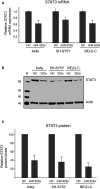Hsa-miR-323a-3p functions as a tumor suppressor and targets STAT3 in neuroblastoma cells
- PMID: 37033189
- PMCID: PMC10079869
- DOI: 10.3389/fped.2023.1098999
Hsa-miR-323a-3p functions as a tumor suppressor and targets STAT3 in neuroblastoma cells
Abstract
Background: Studies conducted in the last decades have revealed a role for the non-coding microRNAs (miRNAs) in cancer development and progression. Several miRNAs within the chromosome region 14q32, a region commonly deleted in cancers, are associated with poor clinical outcome in the childhood cancer neuroblastoma. We have previously identified miR-323a-3p from this region to be downregulated in chemotherapy treated neuroblastoma cells compared to pre-treatment cells from the same patients. Furthermore, in neuroblastoma tumors, this miRNA is downregulated in advanced stage 4 disease compared to stage 1-2. In this study, we attempt to delineate the unknown functional roles of miR-323a-3p in neuroblastoma.
Methods: Synthetic miRNA mimics were used to overexpress miR-323a-3p in neuroblastoma cell lines. To investigate the functional roles of miR-323a-3p, cell viability assay, flow cytometry, reverse transcription-quantitative polymerase chain reaction, luciferase reporter assay and western blot were conducted on the neuroblastoma cell lines Kelly, SH-SY5Y and SK-N-BE(2)-C.
Results: Ectopic expression of miR-323a-3p resulted in marked reduction of cell viability in Kelly, SH-SY5Y and SK-N-BE(2)-C by causing G1-cell cycle arrest in Kelly and SH-SY5Y and apoptosis in all the cell lines tested. Furthermore, mRNA and protein levels of signal transducer and activator of transcription 3 (STAT3) were reduced upon miR-323a-3p overexpression. A direct binding of the miR-323a-3p to the 3'UTR of STAT3 was experimentally validated by luciferase reporter assay, where miR-323a-3p reduced luminescent signal from full length STAT3 3'UTR luciferase reporter, but not from a reporter with mutation in the predicted seed sequence.
Conclusions: miR-323a-3p inhibits growth of neuroblastoma cell lines through G1-cell cycle arrest and apoptosis, and the well-known oncogene STAT3 is a direct target of this miRNA.
Keywords: STAT3; chemotherapy; chromosome region 14q32; microRNAs; neuroblastoma; non-coding.
© 2023 Bhavsar, Olsen, Løkke, Koster, Flægstad and Einvik.
Conflict of interest statement
The authors declare that the research was conducted in the absence of any commercial or financial relationships that could be construed as a potential conflict of interest.
Figures





Similar articles
-
YWHAE long non-coding RNA competes with miR-323a-3p and miR-532-5p through activating K-Ras/Erk1/2 and PI3K/Akt signaling pathways in HCT116 cells.Hum Mol Genet. 2019 Oct 1;28(19):3219-3231. doi: 10.1093/hmg/ddz146. Hum Mol Genet. 2019. PMID: 31238337
-
Hsa-miR-376c-3p targets Cyclin D1 and induces G1-cell cycle arrest in neuroblastoma cells.Oncol Lett. 2018 Nov;16(5):6786-6794. doi: 10.3892/ol.2018.9431. Epub 2018 Sep 11. Oncol Lett. 2018. PMID: 30405823 Free PMC article.
-
Long Non-coding RNA EBLN3P Regulates UHMK1 Expression by Sponging miR-323a-3p and Promotes Colorectal Cancer Progression.Front Med (Lausanne). 2021 May 24;8:651600. doi: 10.3389/fmed.2021.651600. eCollection 2021. Front Med (Lausanne). 2021. PMID: 34109193 Free PMC article.
-
MET/SMAD3/SNAIL circuit mediated by miR-323a-3p is involved in regulating epithelial-mesenchymal transition progression in bladder cancer.Cell Death Dis. 2017 Aug 24;8(8):e3010. doi: 10.1038/cddis.2017.331. Cell Death Dis. 2017. PMID: 28837140 Free PMC article.
-
Long non-coding RNA SNHG7 promotes neuroblastoma progression through sponging miR-323a-5p and miR-342-5p.Biomed Pharmacother. 2020 Aug;128:110293. doi: 10.1016/j.biopha.2020.110293. Epub 2020 Jun 10. Biomed Pharmacother. 2020. PMID: 32534305
Cited by
-
Transcriptional state dynamics lead to heterogeneity and adaptive tumor evolution in urothelial bladder carcinoma.Commun Biol. 2023 Dec 21;6(1):1292. doi: 10.1038/s42003-023-05668-3. Commun Biol. 2023. PMID: 38129585 Free PMC article.
-
LINC00704 facilitates cell proliferation, migration, and invasion via miR-323a-3p/SLC44A1 axis in epithelial ovarian cancer.Discov Oncol. 2025 Apr 29;16(1):640. doi: 10.1007/s12672-025-01866-z. Discov Oncol. 2025. PMID: 40301147 Free PMC article.
-
Beyond Repetition: The Role of Gray Zone Alleles in the Upregulation of FMR1-Binding miR-323a-3p and the Modification of BMP/SMAD-Pathway Gene Expression in Human Granulosa Cells.Int J Mol Sci. 2025 Mar 29;26(7):3192. doi: 10.3390/ijms26073192. Int J Mol Sci. 2025. PMID: 40244008 Free PMC article.
-
Deciphering the roles of non-coding RNAs in liposarcoma development: Challenges and opportunities for translational therapeutic advances.Noncoding RNA Res. 2024 Nov 15;11:73-90. doi: 10.1016/j.ncrna.2024.11.005. eCollection 2025 Apr. Noncoding RNA Res. 2024. PMID: 39736850 Free PMC article. Review.
-
NORAD-Regulated Signaling Pathways in Breast Cancer Progression.Cancers (Basel). 2024 Feb 1;16(3):636. doi: 10.3390/cancers16030636. Cancers (Basel). 2024. PMID: 38339387 Free PMC article. Review.
References
LinkOut - more resources
Full Text Sources
Miscellaneous

